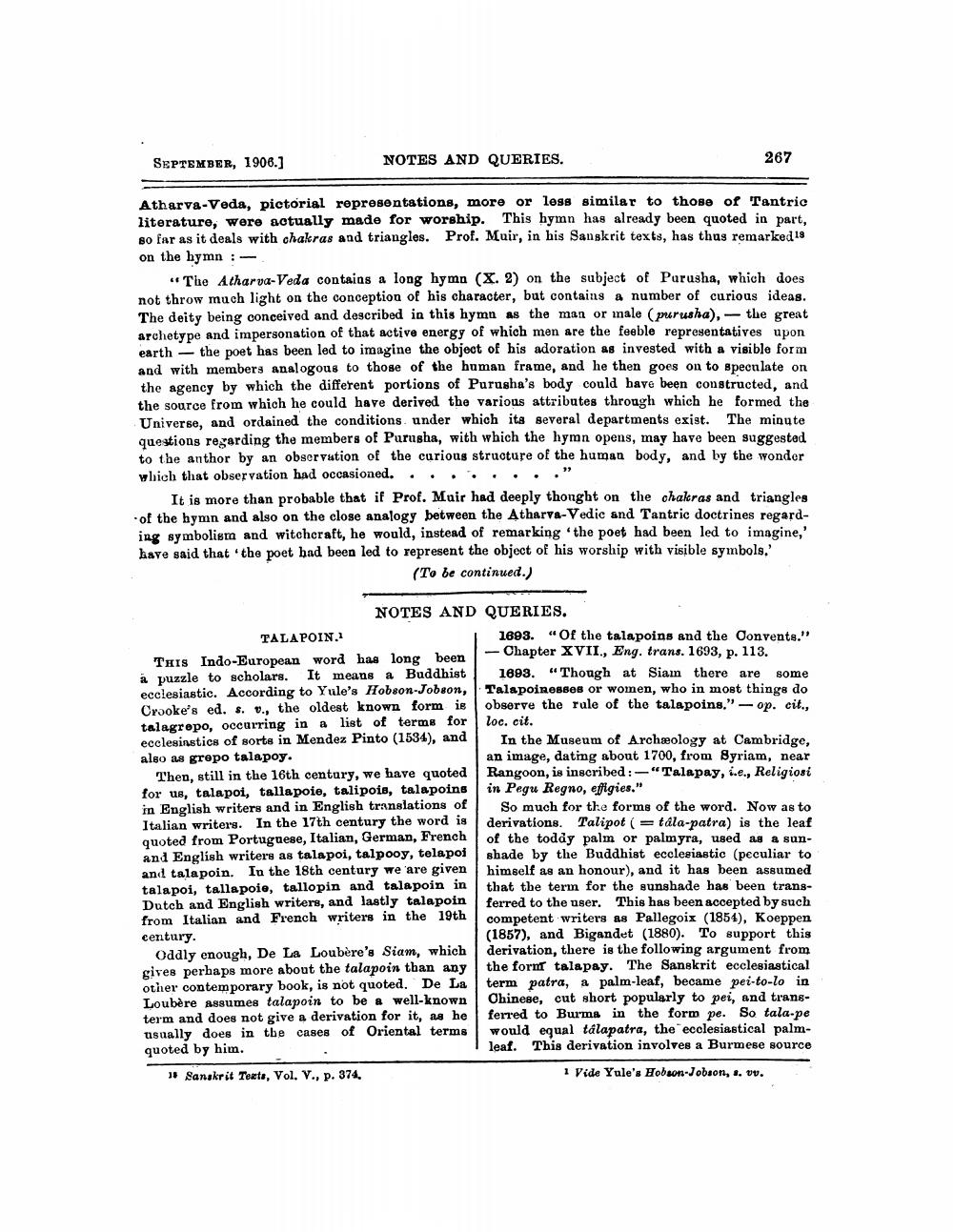________________
SEPTEMBER, 1906.]
NOTES AND QUERIES.
267
Atharva-Veda, pictorial representations, more or less similar to those of Tantric literature, were actually made for worship. This hymn has already been quoted in part, so far as it deals with chakras and triangles. Prof. Muir, in his Sanskrit texts, has thus remarked 19 on the hymn :
"The Atharva-Veda contains a long hymn (X. 2) on the subject of Purusha, which does not throw much light on the conception of his character, but contains a number of curious ideas. The deity being conceived and described in this hymn as the man or male (prusha), - the great archetype and impersonation of that active energy of which men are the feeble representatives upon earth – the poet has been led to imagine the object of his adoration as invested with a visible form and with members analogous to those of the human frame, and he then goes on to specnlate on the agency by which the different portions of Purusha's body could have been constructed, and the source from which he could have derived the various attributes through which he formed the Universe, and ordained the conditions under which its several departments exist. The minute questions regarding the members of Purusha, with which the hymn opens, may have been suggested to the anthor by an observation of the curious structure of the human body, and by the wonder which that observation had occasioned..... . . . ."
It is more than probable that if Prof. Muir had deeply thonght on the chakras and triangles of the hymn and also on the close analogy between the Atharva-Vedic and Tantric doctrines regarding symbolism and witchcraft, he would, instead of remarking the poet had been led to imagine, kave said that the poet had been led to represent the object of his worship with visible symbols.
(To be continued.)
NOTES AND QUERIES. TALAPOIN.
1893. “Of the talapoins and the Convents." Txis Indo-European word has long been - Chapter XVII., Eng. trans. 1693, p. 113. a puzzle to scholars. It means a Buddhist | 1893. "Though at Sian there are some ecclesiastic. According to Yule's Hobson-Jobson, Talapoinesses or women, who in most things do Crooke's ed. s. v., the oldest known form is observe the rule of the talapoins." - op. cit., talagropo, occurring in a list of terms for loc. cit. ecclesinstics of sorts in Mendez Pinto (1534), and In the Museum of Archæology at Cambridge, also as grepo talapoy.
an image, dating about 1700, from Syriam, near Then, still in the 16th century, we have quoted Rangoon, is inscribed :-"Talapay, i.e., Religiosi for us, talapoi, talla poie, talipois, talapoins in Pegu Regno, efigies." in English writers and in English translations of So much for the forms of the word. Now as to Italian writers. In the 17th century the word is derivations. Talipot ( = tala-patra) is the leaf quoted from Portuguese, Italian, German, French of the toddy palm or palmyra, used as a sunand English writers as talapoi, talpooy, telapoi shade by the Buddhist ecclesiastic (peculiar to and talapoin. In the 18th century we are given himself as an honour), and it has been assumed talapoi, tallapoie, tallopin and talapoin in
that the term for the sunshade has been transDutch and English writers, and lastly talapoin
ferred to the user. This has been accepted by such from Italian and French writers in the 19th
competent writers as Pallegoix (1851), Koeppen century.
(1857), and Bigandet (1880). To support this Oddly enough, De La Loubère's Siam, which derivation, there is the following argument from gives perhaps more about the talapoin than any the form talapay. The Sanskrit ecclesiastical other contemporary book, is not quoted. De La term patra, a palm-leaf, became pei-to-lo in Loubère assumes talapoin to be a well-known Chinese, cut short popularly to pei, and transterm and does not give a derivation for it, as he ferred to Burma in the form pe. So tala-pe usually does in the cases of Oriental terms would equal tálapatra, the ecclesiastical palmquoted by him.
leaf. This derivation involves a Burmese source 15 Sanskrit Texts, Vol. V., p. 374.
1 Vide Yule's Hobson-Jobson, 1. vv.




